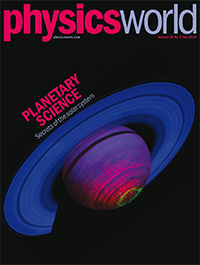 By Matin Durrani
By Matin Durrani
Members of NASA’s Juno mission are bracing themselves for the final moments of the craft’s five-year-long journey to Jupiter, which will finally reach its quarry just a few days from now (late on 4 July in North America, early morning on 5 July in Europe). There’ll be an anxious, 40-minute period of radio silence as the spinning craft fires its thrusters and slows down enough to be captured by the gas giant’s gravity.
During that time, staff at NASA’s Jet Propulsion Laboratory will be waiting, nervously, for Juno’s instruments to flicker back on and allow data-taking to begin as the craft starts a year-long orbit of the planet.
For the inside story of Juno and what it hopes to achieve, don’t miss the July 2016 special issue of Physics World magazine – now live in the Physics World app for mobile and desktop. You can also read the article here.
Devoted to planetary science, the special issue includes amazing images from NASA’s New Horizons mission to Pluto, an investigation into auroras on planets other than Earth, and an analysis of what we know about Vesta and Ceres – the two largest bodies in the main asteroid belt.
Don’t miss either our inside story of Planet Nine, in which Konstantin Bataygin from the California Institute of Technology explains what led him and astronomer Mike Brown to propose the existence of a ninth planet in our solar system.
If you’re a member of the Institute of Physics (IOP), you can now enjoy immediate access to the new issue with the digital edition of the magazine in your web browser or on any iOS or Android mobile device (just download the Physics World app from the App Store or Google Play). If you’re not yet in the IOP, you can join as an IOPimember for just £15, €20 or $25 a year to get full access to Physics World digital.
For the record, here’s a run-down of what else is in the issue.
• SESAME readies for start-up – Richard Blaustein looks at how the Synchrotron-light for Experimental Science and Applications in the Middle East will boost science in the region once complete later this year
• See like a solar system – Robert P Crease discusses what the science of the solar system teaches us about perception
• Supporting the professionals – Marc Delcroix says that amateur astronomers can play a key role when it comes to future planetary missions
• Brave new Jupiter – With NASA’s Juno mission to Jupiter arriving this month, researchers look to our local, ancient behemoth to figure out how planets form – including our own – as Stephen Ornes reports
• Pathway to Planet Nine – Konstantin Batygin explains what led him and astronomer Mike Brown to propose the existence of a ninth planet in our solar system
• Our new view of Pluto – NASA’s New Horizons mission has transformed our pixelated view of Pluto – the tiny object lying on the fringes of the solar system. As Cathy Olkin explains, we can now see ancient craters, young glacial plains and layers of haze stretching up to 200 km from the surface
• Extraterrestrial light shows – If you want to see an aurora, you could go to the Arctic. Or you could go to Saturn. Sarah Badman explains how observations of auroras on other planets are revealing new facts about these fascinating and beautiful phenomena
• Between a rock and a cold place – Marc Rayman, mission director of NASA’s Dawn mission, talks to Laura Faye Tenenbaum about what we are learning about Vesta and Ceres – the two largest objects in the main asteroid belt
• Another giant leap – Lisa Ruth Rand reviews Rise of the Rocket
Girls: the Women Who Propelled Us, from Missiles to the Moon to Mars by Nathalia Holt
• Fang Lizhi, physicist and dissident – Richard McCray reviews The Most Wanted
Man in China: My Journey from Scientist to Enemy of the State by Fang Lizhi
• From physicists to physicians – After completing undergraduate degrees in physics, Henry Drysdale, Ioan Milosevic and Eirion Slade decided their futures lay in medicine. They share their experiences with Physics World
• Once a physicist – Karl Young is a musician who specializes in the Japanese flute, or shakuhachi
• A physicist goes swimming – John Evans from MMI Engineering, UK, completes a triathlon of Lateral Thoughts
The installation of the ‘light source’ SESAM synchrotron in Jordani has a tortuous journey due to the repeated financial and (geo)political problems. The hope is that its operation soon would not suffer from the same difficulties.